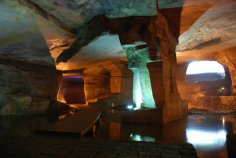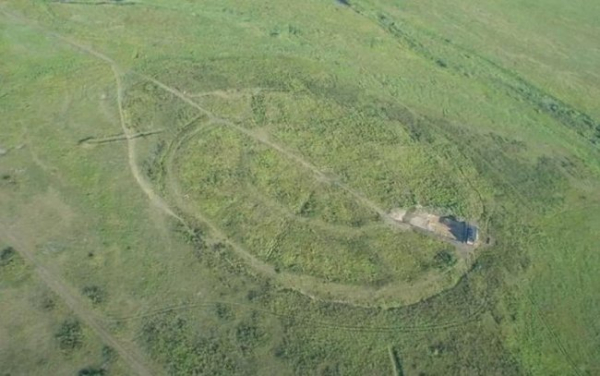
These mysteries are so numerous that many simply shrug their shoulders. Sinologists, historians, and geologists are trying to unravel them. Why, and by whom, did so many enormous caves carve out of these inaccessible cliffs many centuries ago? Why were they developed? What exactly happened within them? Why aren't they mentioned in historical chronicles? And the most intriguing fact is that the Huashan Caves were discovered relatively recently—in the late 1990s.
In 1999, they were discovered by chance by a local farmer who reported the caves to the authorities. Numerous researchers, researchers from various institutes, and then tourists flocked to the site. What's surprising is that, although these are the largest caves in China, created not by nature but by man, there's no mention of them in ancient chronicles. Who created them and for what purpose? Where did such a large quantity of stone disappear to? And if quarrying was the goal, why are the caves constructed to resemble temples?
The Huashan Caves are located in the cliffs of southern Anhui Province. This area is home to the Yellow Mountain, sacred to Taoism. The Yellow Mountain is essentially five great mountains, located a mile or two apart. They point to the cardinal directions: center, south, north, west, and east. Mount Huashan is the western great mountain, home to several Taoist monasteries. Currently, 36 caves have been discovered here, but the exact number is unknown. Furthermore, it is unknown whether they are connected into some sort of unified complex or whether each is located separately. Another intriguing feature: the Huashan Caves are located at 30 degrees north latitude, the same parallel that includes Mount Kailash in Tibet, the Bermuda Triangle, the Great Pyramids of Egypt, and other “anomalous” points on the planet. Is this a coincidence, or did someone deliberately carve the caves at this latitude?
One of the caves, named Huanxi, has an area of 4,800 square meters and a length of 140 meters. Inside, there is a spacious hall, columns, pools, and several smaller chambers on both sides of the cave tunnel. The largest cave is known as the “underground palace.” Its dimensions are staggering: 12,600 square meters. The artificial origin of the caves is confirmed by stone bridges over the river, staircases, passages, and large columns. Furthermore, numerous chisel marks remain on the ceilings and walls. Another intriguing question: where did the stonemasons dispose of the enormous quantities of stones and rubble? And how did they manage to precisely match the angle of the interior walls to the angle of the mountain's exterior? What technologies did the ancients use to create such a unique interior? How and with what was the interior illuminated?
Each of these questions can be answered with various theories, but none has yet been substantiated. However, this is far from the only case where scholars have only speculation. For example, the famous star-shaped ribbed towers in Tibet: there are no written records of them or their creators. The only written mention of Mount Huashan, but not of its caves, is found in the works of a Han Dynasty historian. He states that many famous Chinese emperors loved the mountain and often came to pray to the gods and ancient ancestors. How people managed to climb its steep slopes, and how long it took, is also unknown. Since ancient times, the mountain's summit has been accessible only via a narrow, winding path 12 kilometers long. Those wishing to perform any religious ceremonies or rituals on its summit must have had considerable determination.
All of the above leads to the conclusion that Mount Huashan, striking in its beauty, held a special status among the ancient inhabitants of these areas. However, we don't yet know any details. If we did, we might be able to guess what compelled the inhabitants to expend so much effort carving passages and caves within this sacred mountain. The National Tourism Administration of the People's Republic of China has taken significant steps to ensure access to these caves for travelers and tourists. Experts from one university have developed a project for the development of the cave complex, which includes cave lighting. The multi-colored illumination is incredibly beautiful, lending the caves a truly magical atmosphere. Each cave is numbered, and some are open to visitors.
According to tourist websites, even during a preliminary inspection of the caves, experts were struck by the sheer scale of what they saw. None of the known complexes is larger than Huashan. For example, the total area of just two of the caves—Caves 2 and 35—exceeds 17,000 square meters. The volume of rubble and soil removed from these caves reached 20,000 cubic meters. Pumping out 18,000 tons of water required three pumps and more than 12 days. These caves are now open to the public. Cave 35 contains 26 stone columns, all of which have a whimsical, multi-tiered design. Here you can admire stone terraces, pavilions, pools and ponds, and stone bridges. Bas-reliefs are also found in some areas.
But the question remains: why were these caves discovered only in modern times? And how long have they existed? There is only indirect evidence: analysis of the walls and stalactites revealed that they are at least 1,700 years old. Several ceramics were also discovered, which experts attributed to the Jin Dynasty (265-420), allowing the caves to be dated to approximately that period. But for now, this is only speculation. Huashan still holds mysteries for researchers.





